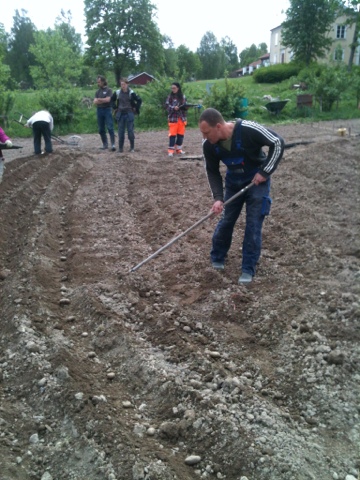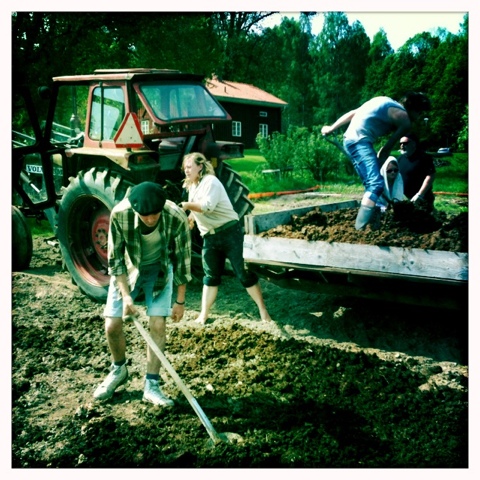Thursday, May 31, 2012
WARNING! Planting Beans
Plant Beans outdoors ONLY if the soil temperature is at least 15'C. They must have warm soil!!! For that reason we keep them in the greenhouse until the outdoor temperature gets up.
Wednesday, May 30, 2012
Luxurious Dilemma
Eating meat ... to meat or not to meat ... many people are starving from hunger ... yet I have the luxury to stress about this issue ... to meat or not to meat ... im not hungry enough to let go of this dilemma.
We got the Hens
We got 3 gorgeous chicks and one handsome Cock ;D
They are still a bit stressed because of the move hence such bad photo.
They are still a bit stressed because of the move hence such bad photo.
The Shadowed Hive
The hive is surrounded by tall trees which are casting a shade over it. I felt that bees might enjoy more sun so i asked Jan to climb the tree and cut a few big branches away. Please dont try this at home unless highly trained like Mr. Jan ;)
Tuesday, May 29, 2012
Constructive Beekeeping by Ed Clark - Condensation and Humidity in a Beehive
"Bees in selecting a home for themselves in a tree, consider
two things upon which their future welfare depends, and in doing
this we can believe that their instinct led them right. First, a
small entrance so that they could easily protect themselves from,
their enemies. Second, a cavity in the tree of sufficient capacity
to carry on the work of the hive, and small enough to keep themselves and their brood from being harmed by outside weather
conditions. Never do we find them, in the selection of a home,
paying the least attention to ventilation. Natural ventilation
is a thing that the bees ignore. Every beekeeper has visible
evidence of this truth in his aipary and it cannot be made more
clear by further discussion."
Monday, May 28, 2012
Sunday, May 27, 2012
Bee health: the treatment (or not) of diseases and parasites. Condensation and varroa! Missing link to survivalists
After re-reading this post on biobees.com I decided to close down the hive floor. There is still a small gap between the meshfloor and the floor, so some ventilation will be present but not as much.;
"That study is available here and shows that, at 70% humidity, Varroa reproduce at the highest rate, whereas at 80% they almost stop reproducing completely. In other words, every 1% increase in humidity above 70% in the brood area hurts Varroa.
"That study is available here and shows that, at 70% humidity, Varroa reproduce at the highest rate, whereas at 80% they almost stop reproducing completely. In other words, every 1% increase in humidity above 70% in the brood area hurts Varroa.
This suggests that a perfect hive for Varroa control would be one that allows the bees to maintain as a high a humidity as possible in the brood cells.
So
Small entrance
No through ventilation
No bottom screen
Old comb if possible (to buffer humidity)
Small cells??
Non-porous hive walls?? "
-----
I want to share with you the most fascinating thing on bees I have ever read outside biobees.com. In the latest issue of NordBi-Aktuellt, the Journal of the Swedish Association for Preserving Apis mellifera mellifera, Swedish researcher Tobias Olofsson at the University of Lund describes his work on lactic acid bacteria. On the subject of hive atmosphere he writes (in my own humble translation from Swedish):
"Lactic acid bacteria form organic acids such as lactic, acetic and formic acid. These are acids used by beekeepers to combat mites and nosema. Lactic acid bacteria are numerous and resemble small factories in the hive where they prosper in the honey stomach, bee bread, bee pollen and honey. Perhaps they produce an arsenal of substances dispersed in the hive's atmosphere? Perhaps the atmosphere in the hive is important to preserve and this would be a reason to disturb the bees as little as possible. Samples from the lab shows that the bacteria produces large amounts of organic acids that seep into the atmosphere. In modern beehives there are bottom screens and entrances at the bottom; how does this affect a potential atmosphere that might prevent disease? The answer is quite logical, but I put the question to Martin Ferm at the Swedish Environmental Research Institute (IVL) in Gothenburg. The organic acids accumulates in a fairly closed room but with a bottom screen with the full thrust of the wind at the bottom and with entrances at the bottom that aired these acids out according to Martin.
Wild bees prefer a hollow tree with only a small gap as opening and they are very careful to seal every crack or hole. We will be investigating this properly: what is the atmosphere like inside a hive if it can be left alone and what does such an atmosphere do to mites? Our pilot study that was conducted in the summer of 2009, in a hive during a typical summer day and while winter fodder was given, was just the beginning. Formic acid and acetic acid were found in the hive atmosphere in the visible amount during a typical summer day and in even larger amounts when the fodder was given.
The Board of Agriculture allocated funds for one-fifth of this project, which means we'll be managing the project on a reduced scale and without pay, but we were thrilled because they dared to bet on such an odd project.
The bees will more or less look after themselves and winter on their own honey. Half of the hives (all of foams) have bottom screen and bottom entrances and the other half have a protected passage in the attic and a completely closed bottom. After 6 weeks, all hives appear to thrive equally well. Data will be collected for a year and will be compared with bacterial organic acids measured with the same equipment in the lab."
Saturday, May 26, 2012
Top Bar Hive Bees Are Doing Great
I have edited the previous video and extended it with a few shots showing the inside of the hive. One can clearly see how bees are building a new comb :)
I am trying to force myself not to treat with anything at all, and its tough but I see it as necessery for the bees to build their own immunity.
For this reason I am so fixated on the closed hive atmosphere even if it is hot outside. Michael Bush keeps his hives closed all year around and he has only high entrances. He does not treat against Varroa at all (not even sugar dusting).
Im thinking to close the hive today and keep it that way. Even if I close it there will be small gaps between the meshfloor and side walls. Michael Bush sais that bees keep a steady temperature inside a hive even if it is much warmer outside. My hive is placed between a few tall Birch trees which shade it ok I think.
For this reason I am so fixated on the closed hive atmosphere even if it is hot outside. Michael Bush keeps his hives closed all year around and he has only high entrances. He does not treat against Varroa at all (not even sugar dusting).
Im thinking to close the hive today and keep it that way. Even if I close it there will be small gaps between the meshfloor and side walls. Michael Bush sais that bees keep a steady temperature inside a hive even if it is much warmer outside. My hive is placed between a few tall Birch trees which shade it ok I think.
Top Bars Wax Stripes
I have seen on you tube a beekeeper making wax stripes on his top bars using cotton string and melting wax on it with the small wellder used by electricians. Smart :) Without these bees might build a comb over a few top bara making comb management impossible. Giving them a dirrection is very important.
BEEing at Kretsloppshuset
Lovely sunny day ... very peaceful at Kretsloppshuset ... Bailey and I decided to make a Bee-Box for all the hive tools. I am greateful for the Anorak i got from my wifes father Jens. Seasoned beekeepers have lots of stuff laying around which they dont use anymore. Ask them nicely and you might get some for free or cheap. I got an Anorak and a Smoker (i use water spray bottle instead because it doesnt stress the bees).
Friday, May 25, 2012
Thursday, May 24, 2012
At The Entrance Of The Top Bar Hive
The bees seem to be very happy with the hive. They are flying back to it with lots of pollen, in and out in and out, zooming they are :) I came too close to the entrance with the camera and the bees decided to kiss me in the cheek :) I Got Stung :D ha ha for that reason this video is short!






















































